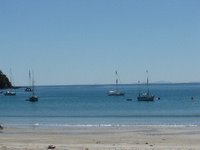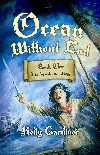Sea gypsies
As I was driving home last night I looked out to sea and there, in the cove, it seemed as if someone had built, magically, a whole new town. Lights glowed soft yellow all across the bay - a village of boats.
The sky and sea were clear and bright blue this morning. There wasn't anyone much on the beach: three women walking their dogs and talking non-stop; a man swimming long breast-stroke laps; a roadwork crew in bright orange vests eating meat pies for breakfast; three cormorants, a few dozen gulls, millions of cockle shells, a dead fish, and me.
But the bay was filled with boats - not the normal pleasure cruisers or catamarans that often spend the weekend here (I live on an island). These were boats that people lived on, with bikes strapped on deck, and dogs, and washing hanging from the rigging: just the way people lived for centuries, and still do in some places in the world.
There was a solid blue ketch, possibly a converted fishing trawler, and many well-rigged ocean-going yachts - all small ships, really, able to weather storms and high seas, and big enough for a few people to live on.
It's not like the pirate days, of course. Now they have global positioning systems and solar panels and stainless steel barbeques and probably dishwashers for all I know. But still, it'd be a wonderful life.
I don't know why they all suddenly appeared. Perhaps they travel together. Or maybe it was a sea gypsy conference. Or just a wonderful coincidence.
All I can report is that it's very hard to concentrate on walking fast when there are too many boats to look at. By 8.30 when I'd finished my walk, there were lots more people on the beach: joggers with grim faces and sweat stains; yappy dogs with legs about an inch long; three back-packers screaming as they ran into the cold water; two German tourists wearing those complicated khaki trousers with a thousand pockets; and me.
A man came out onto the deck of the ketch, stretched and yawned, and sat down with a cup of tea. Nobody else seemed to be awake on the boats.
Imagine waking up and wondering, "Where shall we sail this morning? Or will we just stay here and laze about on the beach?"
It was such a bright day, you could see the outlines of all the other islands, and even the valleys on Great Barrier which are often hidden in seamist.
But I had to go. There was work to do.

When I drove back into town at lunchtime the local school was having a sports day on the beach and the tourist buses were unloading people for a picnic. A handful of gleaming white yachts lay at anchor. And yet somehow the bay seemed deserted.
The sea gypsies had gone.



